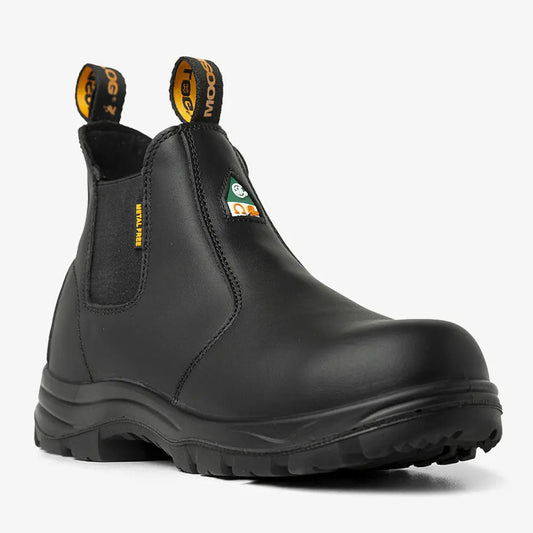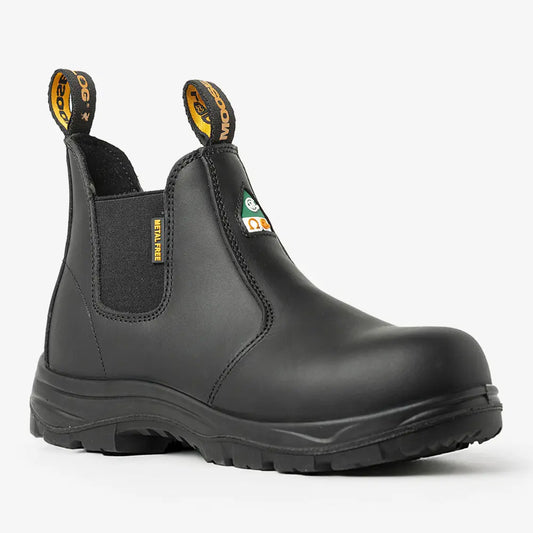
Top Features to Look for in EH Rated Work Boots
When your job exposes you to electrical hazards, wearing EH rated work boots isn’t optional—it’s critical. But with so many safety boots on the market, how do you know which pair actually delivers the protection you need?
It all comes down to the features. Whether you're shopping for your first pair or upgrading to something more durable, knowing what to look for will help you find boots that are both safe and comfortable.
In this article, we break down the top features to look for in EH rated, puncture-resistant work boots, ensuring you're well-equipped for any job site.
1. Electrical Hazard (EH) Rating
This one’s obvious—but it’s also the most important.
EH rated boots are designed to provide secondary protection against electric shock. They feature non-conductive soles and heels that can withstand up to 18,000 volts under dry conditions. These are essential for workers in:
- Electrical utilities
- Construction
- Manufacturing
- Maintenance and repair
Make sure your boots are CSA or ASTM certified, which ensures they’ve passed rigorous testing for EH protection.
Check the official standards here:
2. Puncture-Resistant Midsoles
Electrical protection is critical, but so is protection from sharp objects. Whether it’s nails on a construction site or metal debris in a factory, puncture-resistant midsoles are a must.
Look for boots with:
- Steel or composite plates between the insole and outsole
- CSA Grade 1 designation (required for puncture resistance in Canada)
- Reinforced outsoles for underfoot protection
This combination not only protects against foot injuries—it also maintains the electrical insulating barrier of the boot.
3. Non-Metallic or Composite Toe Caps
EH rated boots must not contain conductive materials in critical areas. That’s why composite or fiberglass toe caps are often preferred over steel for electrical work.
Benefits of non-metallic toe caps include:
- No conduction of electricity
- Lightweight feel
- Temperature insulation (no cold transfer)
- Compliance with CSA and ASTM safety standards
If your job requires impact and compression protection, be sure the boot also meets I/75 and C/75 ratings under ASTM or Grade 1 protection under CSA.
4. Durable, Non-Conductive Outsoles
The outsole is your first point of contact with the ground. For EH rated boots, it must be thick, abrasion-resistant, and non-conductive.
Look for outsoles made from:
- Rubber or polyurethane
- Dual-density materials for shock absorption
- Slip-, oil-, and abrasion-resistant tread patterns
Some EH rated boots also offer ladder grips or heel stabilizers—great features for workers in construction or utility jobs.
5. High-Quality Construction Materials
Your boots need to stand up to daily wear in tough environments. Quality materials help ensure both protection and durability.
Look for:
- Full-grain leather uppers for toughness and long-term wear
- Reinforced seams and toe guards for impact resistance
- Stitching that holds up under stress
- Soles that are heat- or abrasion-resistant
Premium materials not only last longer, but they also maintain the integrity of EH and puncture-resistant protection over time.
6. Comfortable Fit for Long Shifts
Safety doesn’t mean much if the boots hurt your feet. Comfort features help you stay focused and reduce fatigue during long workdays.
Key comfort features include:
- Padded collars and tongues
- Cushioned footbeds for arch support
- Shock-absorbing midsoles
- Lightweight design to minimize fatigue
Choosing boots that fit well and feel good can make a huge difference in your productivity and overall well-being on the job.
7. Moisture and Debris Management
While EH boots are tested under dry conditions, job sites aren’t always clean and controlled. Look for features that help keep your feet dry and clean internally.
Recommended features:
- Gusseted tongues to keep out debris
- Breathable linings that reduce sweat
- Quick-drying materials for indoor use
Although we’re not focusing on waterproof features in this series, internal moisture control still contributes to overall comfort and hygiene.
8. Easy On/Off Design
In fast-paced environments, ease of use is a big plus. Consider:
- Pull-on loops for quick wear
- Speed lacing systems
- Side zippers on high-cut boots for easy removal
While these don’t affect safety directly, they enhance your daily experience and make gear changes faster and smoother.
9. CSA and ASTM Labels
Never buy work boots without verifying their certifications. Check for:
- ASTM F2413 label (for U.S.)
- CSA Z195 label with omega symbol and green triangle (for Canada)
Boots sold on MooseLog.com are clearly marked with the appropriate certification info, so you know you’re getting verified protection.
Bonus: Style That Works
Let’s be honest—you want your work boots to look as good as they perform. Thankfully, modern EH rated work boots come in a variety of styles that don’t compromise on safety.
From sleek black leather to rugged outdoor aesthetics, brands like MooseLog combine performance with visual appeal, so you can feel confident and look professional.
Final Thoughts
Choosing the right EH rated work boots is about more than just checking a safety box. The best boots combine electrical hazard protection, puncture resistance, comfort, and durability—all certified to CSA or ASTM standards.
When shopping for your next pair, prioritize the features outlined here. From non-conductive soles and composite toe caps to high-quality materials and smart design elements, every detail matters when your safety is on the line.
Looking for boots that check all these boxes? Visit MooseLog.com for lightweight, CSA and ASTM certified, puncture-resistant EH rated work boots designed for serious professionals.






